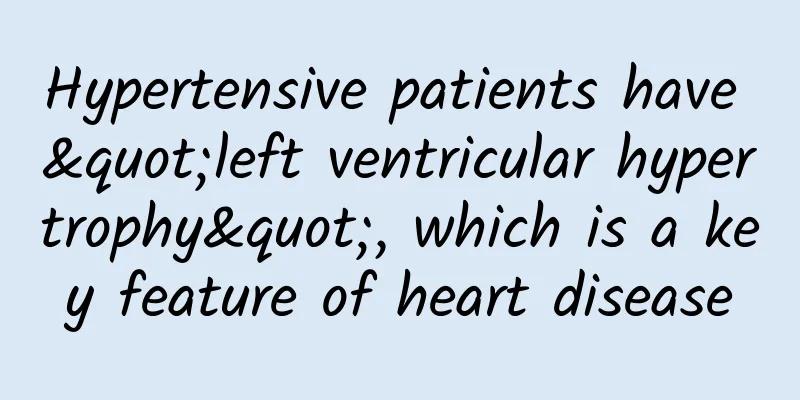Hypertensive patients have "left ventricular hypertrophy", which is a key feature of heart disease

|
A friend who suffers from high blood pressure told Huazi that he had a cardiac ultrasound a while ago and found "left ventricular hypertrophy". Is this a heart disease? But he himself did not feel any discomfort. Huazi told him that left ventricular hypertrophy is a key feature of hypertensive heart disease. When checking the heart with color Doppler ultrasound, if the thickness of the ventricular wall exceeds 11mm for men and 10mm for women, it is left ventricular hypertrophy. This situation is common in people who have suffered from high blood pressure for many years but have not been able to control their blood pressure well. 1. Hypertension can lead to left ventricular hypertrophy If blood pressure is above 165/95 mmHg for a long time, the possibility of left ventricular hypertrophy is more than 10 times higher than that of people with normal blood pressure. Because high blood pressure means that the resistance of the heart to eject blood increases, but the heart has to ensure blood supply to the body, the human body will increase the contractility of the myocardium under the regulation of nerves, endocrine and other factors. If this continues for a long time, the myocardium will hypertrophy. This is just like the effect of lifting weights when we exercise, allowing muscles to overcome resistance and become thicker. In addition to high blood pressure, aging, genetics, obesity, and excessive salt intake are all risk factors for left ventricular hypertrophy. 2. The hazards of left ventricular hypertrophy There are no obvious symptoms in the early stages of left ventricular hypertrophy, but the disease will continue to progress and cause harm to the body. After left ventricular hypertrophy, the diastolic function of the left ventricle will weaken, which will affect the blood return of the pulmonary circulation and cause pulmonary congestion, so symptoms such as chest tightness, shortness of breath, and difficulty breathing will appear. After left ventricular hypertrophy, the demand for blood supply increases, but the microvessels in the ventricular wall are squeezed by the hypertrophic myocardial cells, and the blood supply resistance increases. Hypertension can lead to atherosclerosis, causing the coronary arteries to become narrow, resulting in insufficient blood supply to the myocardium and a decline in the heart's blood transport function. Hypertrophic myocardium is prone to arrhythmias, and if ventricular fibrillation occurs, it may lead to sudden death. Moreover, when the left ventricle is hypertrophied, the upstream left atrium will also expand accordingly, which may damage the electrical conduction pathway between myocardial cells and cause atrial fibrillation. Atrial fibrillation can cause wall thrombus and easily induce cerebral infarction. If left ventricular hypertrophy is allowed to progress, it will develop into heart failure, which is the terminal stage of all cardiovascular diseases and will eventually lead to death due to insufficient blood supply to vital organs. 3. How to reverse left ventricular hypertrophy What should you do if you have left ventricular hypertrophy? Find a way to reverse it! The best way to reverse left ventricular hypertrophy is to lower your blood pressure. In studies on left ventricular hypertrophy, it has been confirmed that lowering blood pressure can effectively reverse left ventricular hypertrophy. People with high blood pressure need to gradually lower their blood pressure over several months, with the ultimate goal of keeping blood pressure below 130/80 mmHg. Sartans are the first-line antihypertensive drugs that have a better effect on reversing left ventricular hypertrophy, followed by dihydropyridines, prils, diuretics, and loral drugs. Prils can inhibit the renin-angiotensin-ketosteroid system (RAAS) and increase bradykinin levels, which can protect the cardiovascular system through dual systems. No matter how you choose antihypertensive drugs, the most important thing is to lower blood pressure to the standard. Most people need to use multiple antihypertensive drugs in combination to achieve the standard blood pressure. It should be noted that both sartan drugs and pril drugs work by inhibiting RAAS. You can choose one of them and cannot use them together. While controlling blood pressure, you should also maintain a healthy lifestyle, control your weight, limit salt intake, quit smoking, quit drinking, have a regular work and rest schedule, and do as much exercise as you can. A healthy lifestyle is just as important as medication. To sum up, left ventricular hypertrophy is a key feature of hypertensive heart disease. Once it occurs, blood pressure must be strictly controlled under the guidance of a doctor to try to reverse left ventricular hypertrophy. However, it is difficult to cure "already sick". It is the most important thing to control blood pressure, avoid the occurrence of diseases, and treat "not sick". Drugs must be used under the guidance of a doctor. If you have any questions about medication, please consult a doctor or pharmacist. I am pharmacist Huazi. Welcome to follow me and share more health knowledge. |
Recommend
What are the six female endocrine examinations?
Endocrine is very important for women. In clinica...
What should women do if they have itching down there?
Women seem to be naturally weaker, so they must l...
Is there always some bleeding during the 10th day of menstruation?
Menstruation is a normal physiological phenomenon...
What are the dietary taboos during the IVF down-regulation period?
IVF downregulation refers to a treatment method f...
Acne and irregular menstruation? This endocrine disease is to blame
Among the women who love beauty, some are curious...
This niche vegetable is extremely high in selenium and helps with anti-aging! You will regret not eating it this season...
When it comes to delicious melons, everyone will ...
HPV vaccine is trending again! What is the best price? Can I get vaccinated if I'm already infected with HPV? Here's a complete guide!
Today, #Experts say you don't have to worry a...
[Medical Q&A] It’s the peak season for allergies again. Do you know how to treat allergies?
Author: Wang Changyuan, Chief Physician, Xuanwu H...
What is the reason for my period to be late for a week?
Menstruation is a physiological cycle that every ...
Understand in one article | The more you scratch, the more itchy it becomes. How to correctly deal with uremic pruritus?
Itch is a common and painful symptom in patients ...
Is it good for a woman to have a mole on her right neck?
Although black moles are somewhat unpleasant, the...
Can pregnant women eat sea cucumber millet porridge?
Although pregnant women need to consume more nutr...
There is yellow discharge in the girl's underwear
It is necessary to pay attention to yellow secret...
The relationship between hcg and progesterone
Pregnant women need to do some prenatal tests to ...
Purpose of endometrial biopsy
In fact, the technology of endometrial biopsy is ...









